This post is about behavior. Please don’t expect high quality images…
Last March I found this juvenile (I believe) Rough-legged Hawk along the Antelope Island causeway on a cold morning after a light snowfall. It was perched on a windrow of debris consisting mostly of piles of old brine fly pupae casings.
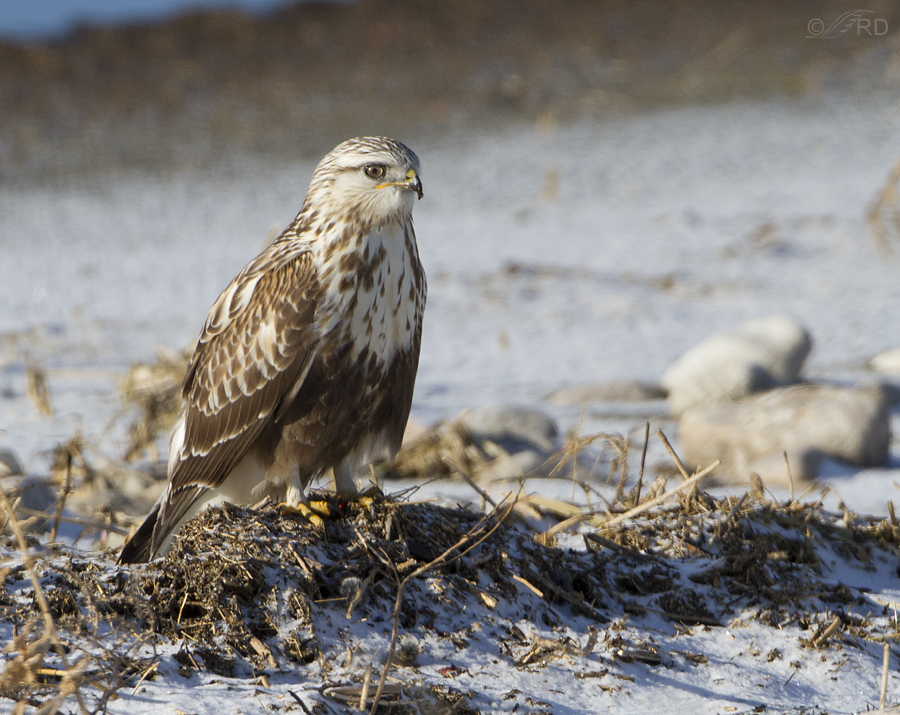
For a while the bird seemed content to simply rest and watch me. But soon it apparently got bored…
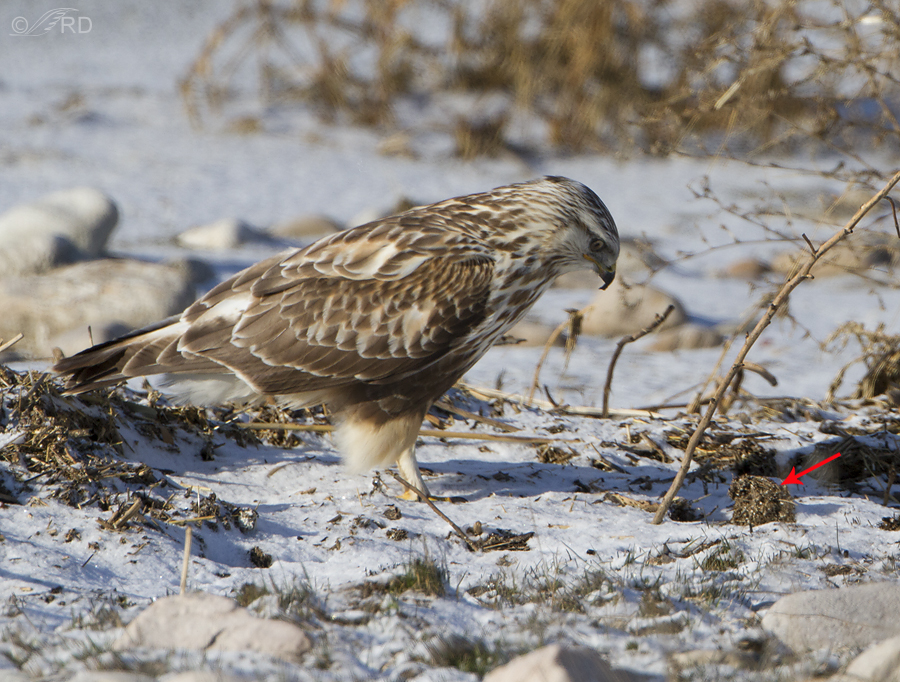
and walked about two feet to my right to investigate a clump of fly casings (red arrow) that had been cemented together by melting snow that had re-frozen during the night.
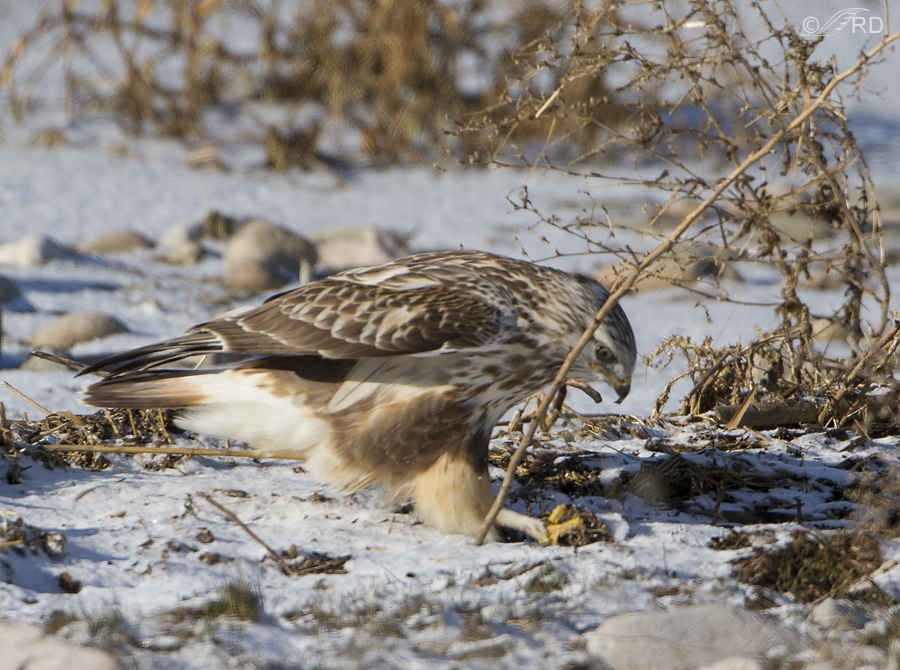
The hawk reached over to grasp the clump with its talons…
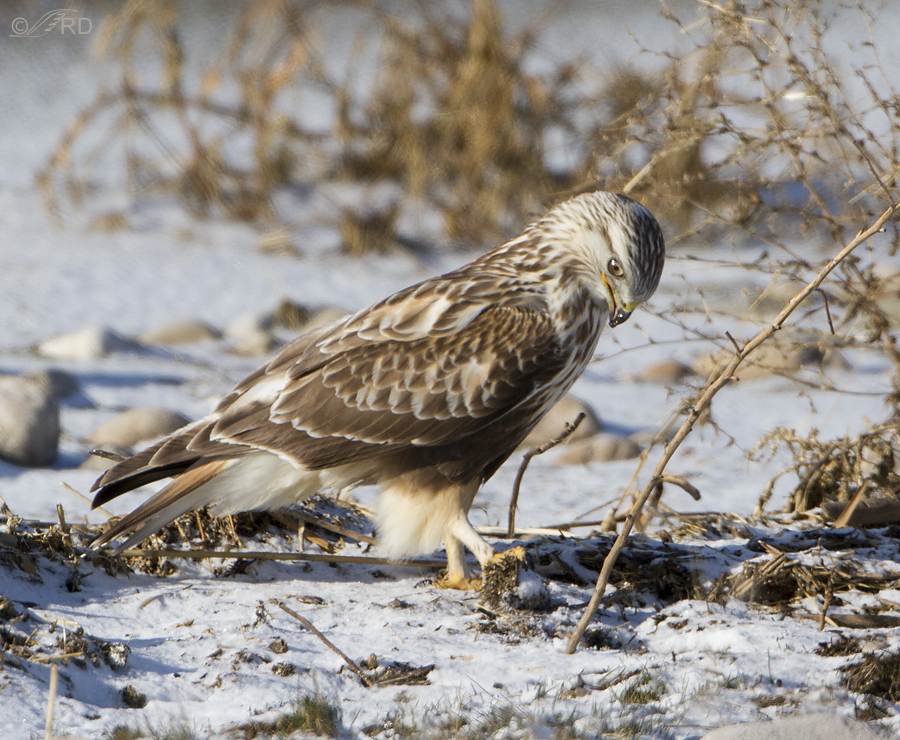
retrieved the clump,…
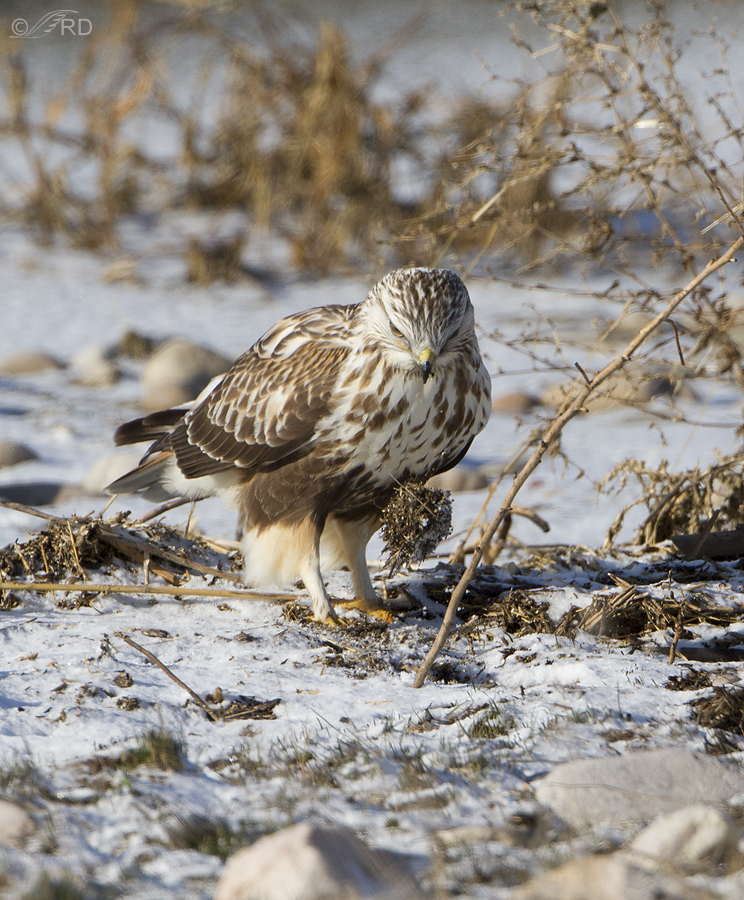
transferred it to its beak and then instantly tossed it to the ground. I assumed that was that, figuring the bird had thought it might be something edible, then discarded it for good when it wasn’t. But that wasn’t what happened.
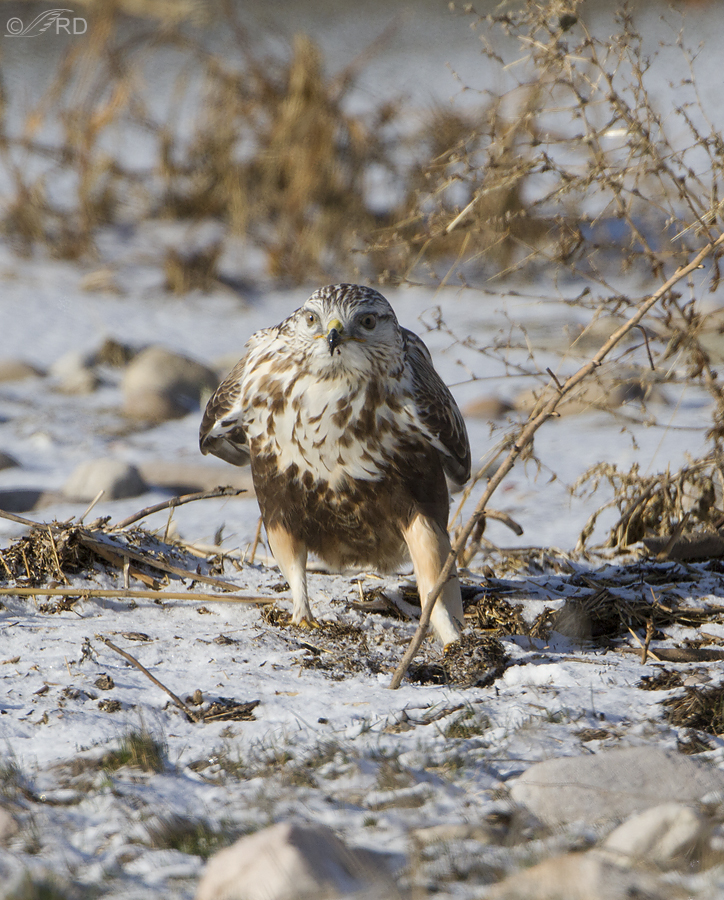
The hawk grabbed the clump with its talons once again…

and then seemed to contemplate for a few seconds about just what to do next.
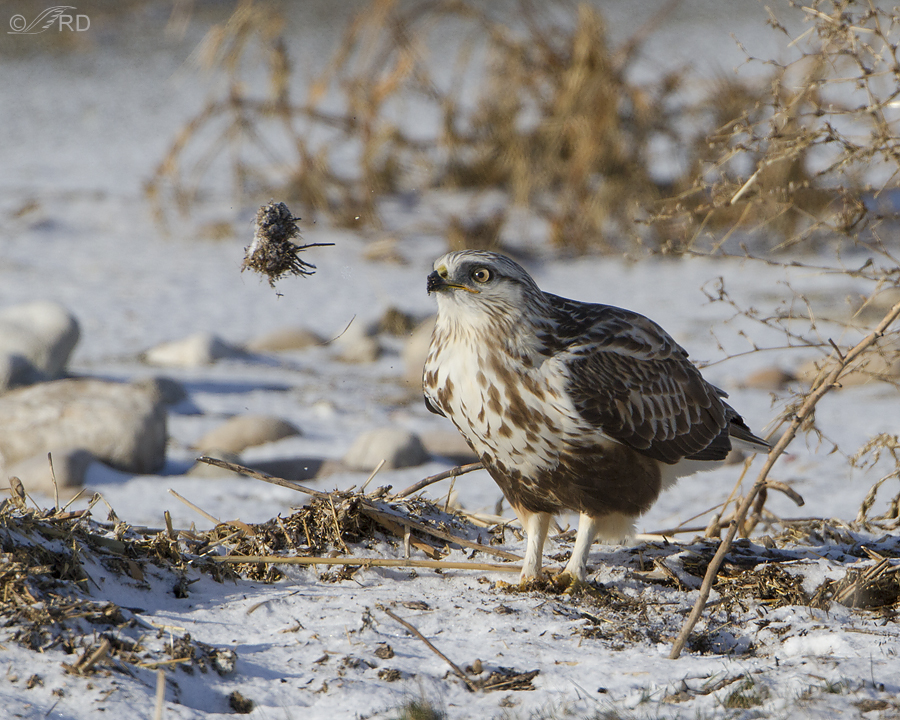
Which turned out to be something like “give the clump a toss and see where it lands”.
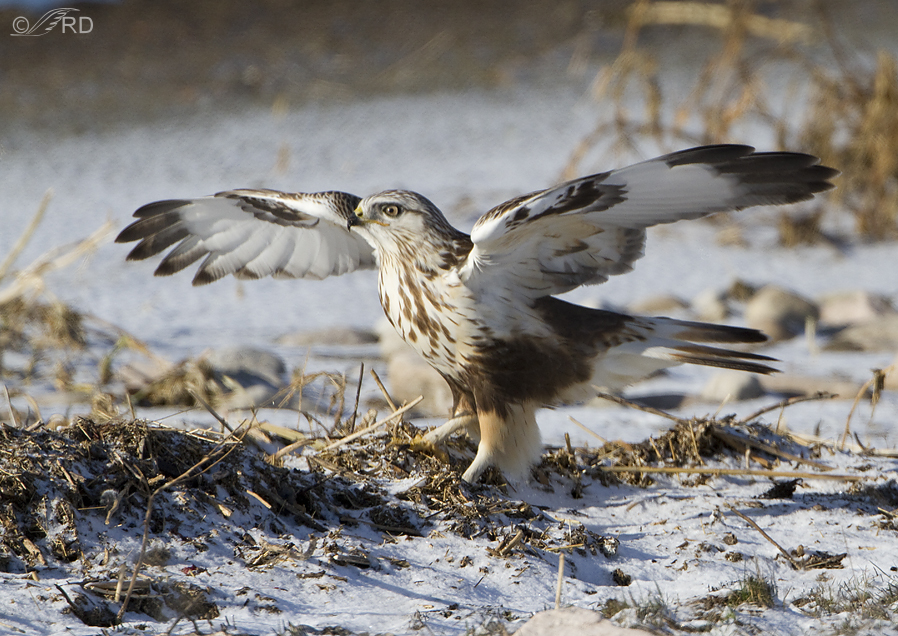
The hawk immediately started walking over to where the clump had landed behind the mound of fly casings, where it can’t be seen in this image. It used its wings for a little more stability as it negotiated the hill of debris.

After picking it up, the hawk flew off with its “toy”. I lost focus on the bird as it did so but wanted to include the image so that you could see that the hawk did take the clump along when it left.
I’m certainly no animal behaviorist but I’m fairly convinced that what I saw was “play”. Play in animals is well documented, including in many bird species. In fact, Birds of North America Online, out of Cornell University, has a behavior category they label “play” for many of the species they cover on their website. For some of those species, several types of play have been well documented. But all they say about play in Rough-legged Hawks is “Group of birds soared, dived, and “played tag” in twos and threes in n. Quebec (Palmer 1988).” I was disappointed to not find more.
I’ve seen many raptors seeming to play with each other in the air – with their own species and even differing species but this is the first time I’ve (apparently) seen play on the ground by a raptor. Motivations for such behaviors are, of course, difficult to assign but I’ll tell you this. Whatever it was, I was absolutely fascinated and intrigued by what I saw that early March morning.
Ron
PS – I’m curious to know of any apparent “play” among birds that any of my readers may have observed, raptors or non-raptors. And the more I think about that, the more curious I become – especially knowing how much experience many of you have with birds…


Nothing like the others have reported, but my observation of birds playing was the common grackle. My wife had placed moth balls in our back flower bed to discourage 4 legged pests and the following day the moth balls were spread around our yard and we couldn’t figure out what was happening until one day we observed a grackle ‘playing’ with the moth ball, picking it up in its beak and tossing it backwards, sometimes rubbing it on its underwing like it was preening. We have since discontinued this practice not wanting to harm the birds, but it was a fascinating behaviour to watch. I’m not sure if this fits the playing category or whether the smell of the the moth balls somehow attracted them.
I have also seen crows pick up cigarette stubs in their beaks and fly off.
Great shots. The actions the focus. I often observe Eagles, Osprey, Great Blue Heron in what looks like play. Mostly juveniles. Juvenile Bald Eagles will often chase Heron of a mooring cell in their feeding area. The juvies chase gulls in both eagles and osprey. Sometimes the roles reverse and the gulls do the chasing. Play, exercise, harassment, who knows for certain. Good exercise, honing skills all a part of it, why not make it fun as we do.
Thanks, Grampy. I agree, “why not make it fun”.
Nice photos. You are a serious bird watcher — I have to share two bird-play observations I’ve made many years apart. In the 1970s I was working in Ketchikan, Alaska and was walking near the waterfront watching a raven soaring high over the water — maybe 2-300 feet. I watched as it dropped something from it’s talons. The bird let the object (a clam?, rock?) freefall for maybe 40 feet or so and then tucked it’s wings and did a dive, catching the object again and proceeding to gain altitude. It did this at least three times for no obvious reason other than fun. About five years ago I was pheasant hunting on farmland in eastern Washington and watched redtail hawk do a similar drop and recover several times in a row, but this time it let the object (looked like a cowpie?) hit the ground each time. Again, not food, and very deliberate drops. In my opinion birds are intelligent animals that seek stimulation. Again, fantastic pics — Mark U
Great examples of birds playing, Mark. Thank you for sharing them. I’ve heard of these types of behaviors in raptors and corvids but I’ve never seen them. Sure would like to though…
Great stuff Ron! Yes this bird is an juvenile.
I have observed raptors in seeming play many times. Two instances come to mind. This fall on the ridge, I photographed a juvenile Red-tailed Hawk that had grabbed a pine cone from a tree, and was carrying it about, regularly checking the item it had seized in its talons. It could have mistaken the cone for prey, but I highly doubt that. I can share the images, as poor as they are, especially by your standards.
I have also seen interspecific interactions between young RT’s and Roughies, that left me feeling that they were not engaging in anything like a territorial dispute. The birds seemed to be playing a tag sort of game. I’ve observed interspecific interactions in buteos that were obviously aggressive. An RT and Swainson’s engaged in talon clasping and tumbling, resulting in the RT’s retreat. The young RT and Roughie took turns chasing one another about, amongst a few other birds of both species. This was in a high density wintering area, which also gave confidence to my impression that these birds were not interacting aggressively.
Glad you shared this!
Thanks for those examples, Bryce. With all the time you spend in the field I figured you’d seen your share of play behavior.
Hi Ron, This might be a duplicate posting – internet gremlins at work!
As always, you have captured a beautiful bird displaying wonderful(i.e., “full of wonder”)behavior. Thanks!
My experience with raptors playing can be illustrated by two posts I made to a local (Klamath Basin)birding list serve-
From March 2011: “The LKL Road/Fugate intersection had 4 Golden Eagles playing drop-the-stick. They took turns carrying a 4 ft. long piece of wood into the air and dropping it to the ground. They were all kiting, so we got to watch through our scopes for several minutes. As were leaving, a Prairie Falcon made a kill in the field just below the eagles and had to protect its prey from a couple ot redtails that were attempting to steal it. Again, we had nice (in a cold rain) scope views.”
And,from March of this year:
“Highlight of the day was my lunchtime entertainment. While parked at the intersection of LKL Road and Fugate, I watched 5 Golden Eagles (all imm) and 3 Bald Eagles soaring together and executing perfect pas de deux (as well as a couple of pas de trois). Natural choreography. Nice.”
Please note that both of these sightings were from the same intersection, and both took place in March. Guess where I’ll be in March 2013…
Wow, Dick. Both events you describe would have been wonderful to see but watching GEs playing like that with a 4 ft stick must have been extra special. I think I’d be tempted to “camp out” at that intersection for the entire month of March!
Wonderful story and images. I have seen magpies, jays, and ravens engage in what I can only assume is play; they chase each other and pick up objects and seem to tease each other. Especially now when I put out nuts and seeds for the birds, I am likely to observe this behavior. I think play is a valuable and critical behavior to cement relationships as well as to hone skills just as we humans do. Why else would I play Rock Band with my kids?
I too have seen play behavior in those species, Tana and it’s fascinating to watch. The corvids are considered by many to be the most intelligent of all birds and it seems to me that in the animal kingdom, play generally increases with intelligence. Thanks for your input on this.
Wonderful images and fascinating comments. Thanks so much–it’s made for fun reading this morning.
Sharon
I agree about the comments, Sharon. Thanks so much everyone!
Brilliant sequence. Our cockatoos certainly play. One (and I think it is always the same one) picks up beaksful of leaf litter from the gutter and drops it on my head as I walk underneath. And his/her aim is extremely good. I cannot think of any other explanation other than ‘fun’. It will even scamper along the roof to get to the best vantage spot when it sees one of us about to go out or in. Wet leaf litter or dry doesn’t seem to matter to it – though it does to me.
That’s funny stuff, Elephant’s Child. And very interesting. Endearing behavior, unless you’re the victim of their antics…
Play really is a fascinating thing. In our birds here at the raptor center (and, yes, some of this might be an artifact of captivity), I’ve seen then pounce on leaves, rocks, or sticks and walk around with them in a foot; as part of their enrichment, we give them bunny skins to play with and rip up; those large zucchini no one wants to pounce on and ‘kill’ (great eagle puncture wounds in a nice ripe zuke!); dog retriever training canvas footballs (last about 2 hrs with a golden eagle – expensive!); even sometimes stuffed animals. In fact, we sometimes use stuffed animals as their ‘jackpot’ treat at the end of a training session rather than a larger than usual food reward. Great horned owls in particular like to rip things up … lettuce heads, towels, astroturf … obviously we need to be careful that they don’t ingest something harmful but we’ve trained some of them to catch little dog toy balls in mid-air or to pounce on them as they roll on the ground. Clearly, they know they aren’t food and these are adult birds, not youngsters who often practice on anything that moves. Our large falcons also loved stuffed animals and pouncing (and eating) crickets or meal worms – NOT what they’d find in the wild. And they aren’t hungry – it would seem to be just for fun. How awesome to see this behavior in a wild bird!
Amazing, Louise – simply amazing. I’ve read your comment three times now, each time visualizing what you describe. I’d LOVE to see these behaviors, “artifacts of captivity” or not. Thanks so much!
Hi Ron,
A lot of falconry birds are hard imprinted and they definiately play. I have a friend that has an inprinted Gyr that chases a tennis ball like a dog. I also had an imprinted Gyr-Peregrine hybrid that would sit in my lap (watch the talons!), turn her head upside down and squeak at me until I would reach up and grab her beak. She would do this for hours, and it was definately play.
Young wild birds will chase each other with a food item for hours, never really intending to eat it, but rather playing keep away. Just like with human children, play is a way of sharpening their flying and footing skills. in addition to the fact that they just seem to be enjoying themselves!
Nice pictures. Thanks for sharing.
Mark
Fascinating stuff, Mark! Thanks so much, you’ve been so helpful in so many ways.
I’m curious about something. I think I understand imprinting fairly well (I was very interested in the original work of Karl Lorenz with his geese) but the implication of what you say here seems to be that imprinting somehow contributes to, or increases the amount of, play. If so, any idea why?
Hi Ron,
I am not a biologist, but I have always assumed that it is has to do with how comfortable they are with their surroundings.
I prefer wild caught birds. Jet is a Tundra Peregrine falcon that was caught from the wild just over a year ago. She is as tame as any wild caught bird gets. She will sit on my fist and preen, then tuck her head under her wing and go to sleep. But she is never completely at ease, there is always a wild edge to her and all wild caught birds.
Captive raised, non-imprinted birds are a little tamer, but still essentially the same as wild caught birds.
Imprints, however, are a different story. They don’t think that they are a different species from the humans around them. They think they are among their own kind and become very relaxed. In falcons, this is usually a good thing. They will scream and make a lot of noise, similar to a macaw, but more frequent. With buteos, however, an imprinted bird can be dangerous. They think you are another bird and they don’t treat each other very well. They will often attack the people around them and can do some serious damage. Accipters are not much better. Some falconers understand imprints and get fantastic results with them….I prefer wild caught birds hands-down!
Sorry, off on a tangent again. Back to play. I think that young wild birds play more than we realize when no one is watching. Imprinted falconry birds play much more than wild caught birds due (I think) to the fact that they are more comfortable….they are among their own kind.
Thanks for listening. Still working on that “concise” concept!
Mark
Thanks very much, Mark – your explanation seems entirely logical. And I doubt that a more “concise” version would have done the job nearly as well. I’m still learning…